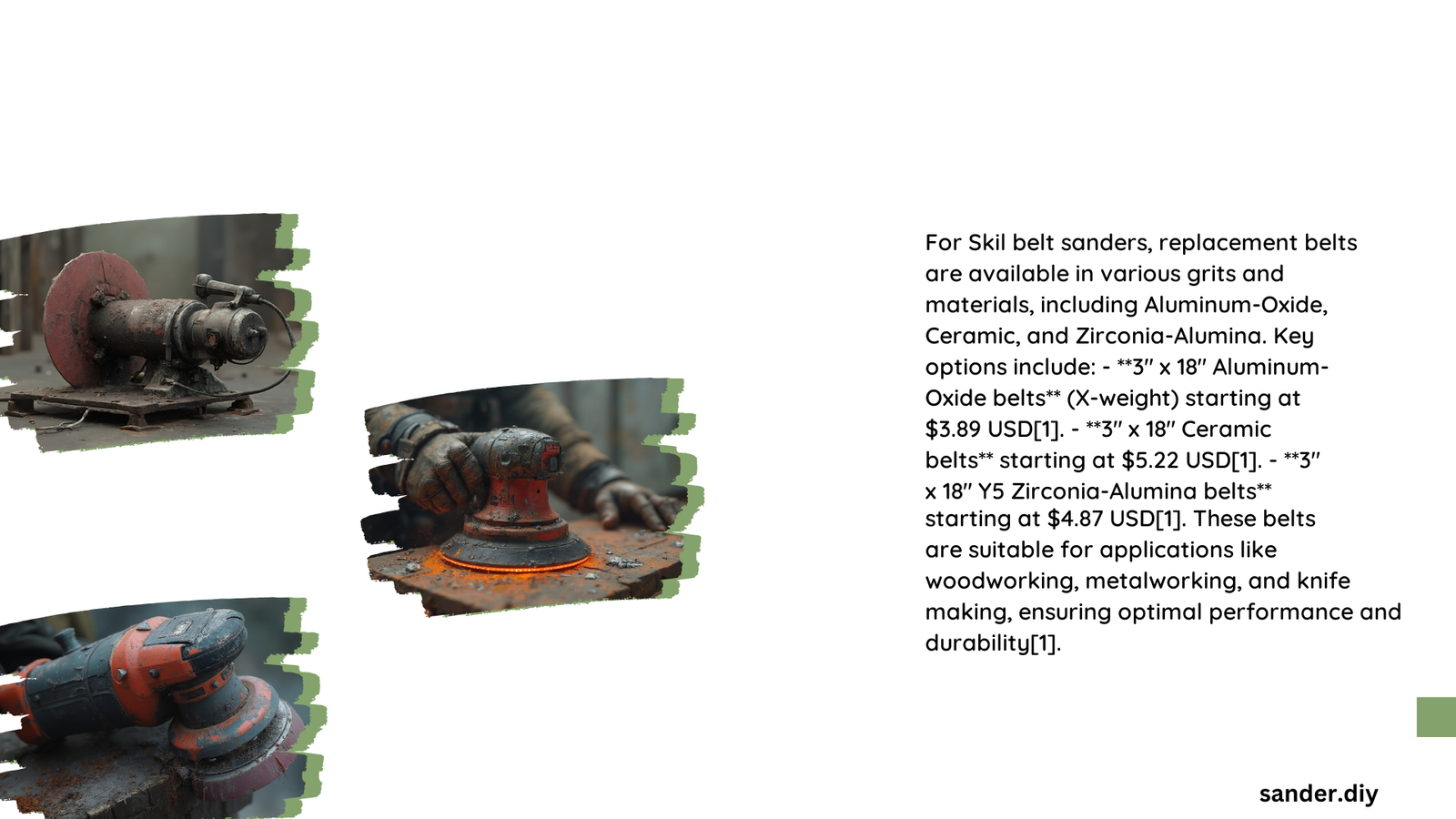Skil belt sander replacement belts are crucial components for maintaining the efficiency and performance of your Skil belt sander. These belts come in various sizes, grits, and materials to suit different models and sanding needs. Choosing the right replacement belt ensures smooth operation, extends the life of your sander, and achieves desired results across various woodworking and DIY projects. This comprehensive guide covers everything from specific sizes for different Skil models to cost considerations and performance tips.
What Are the Specific Sizes for Skil Belt Sander Replacement Belts?
Skil belt sanders come in various models, each requiring a specific belt size for optimal performance. Here’s a breakdown of common Skil models and their corresponding belt sizes:
- SKIL 3376 Belt/Disc Sander: 4 x 36 inches
- SKIL 7510-01 Belt Sander: 3 x 18 inches
- SKIL 7313 Belt Sander: Typically uses standard sizes like 3 x 18 inches or 4 x 36 inches
- SKIL 400 Belt Sander: 4 x 21 inches or 4 x 21 3/4 inches (some ambiguity exists)
It’s crucial to match the belt size precisely to your Skil model to ensure proper fit and functionality.
Which Brands Offer Compatible Replacement Belts for Skil Sanders?

When looking for replacement belts, you have two main options:
- SKIL Branded Belts: These are designed specifically for Skil sanders and guarantee compatibility.
- Third-Party Belts: Many reputable brands offer compatible belts that match Skil specifications.
Here’s a comparison table of some popular brands:
| Brand | Compatibility | Price Range | Quality |
|---|---|---|---|
| SKIL | Guaranteed | $$$ | High |
| 3M | Wide range | $$ | High |
| Norton | Most models | $$ | High |
| Diablo | Select models | $$ | High |
| Generic | Varies | $ | Variable |
Always ensure the third-party belt matches your Skil sander’s size and specifications.
What Grit Options Are Recommended for Skil Sander Replacement Belts?
The grit of your sanding belt determines its abrasiveness and the finish it produces. Here are recommended grit options for different tasks:
- Coarse (40-60 grit): Rapid material removal, stripping paint
- Medium (80-120 grit): General purpose sanding, smoothing rough surfaces
- Fine (150-180 grit): Preparing surfaces for finishing
- Very Fine (220+ grit): Final sanding before applying finish
Choose your grit based on the specific task and desired outcome. For most projects, it’s beneficial to progress through multiple grits for the best results.
How Does Belt Material Affect Sanding Performance?
The material of your sanding belt can significantly impact its performance and longevity. Common materials include:
- Aluminum Oxide: Versatile and durable, suitable for most woodworking tasks
- Zirconia Alumina: Excellent for hard materials, lasts longer than aluminum oxide
- Ceramic: Premium option, offers the longest life and fastest cutting action
- Silicon Carbide: Best for sanding non-wood materials like metal or plastic
Consider your typical projects when selecting belt material to optimize performance and cost-effectiveness.
What Is the Cost Analysis for Purchasing Skil Belt Sander Replacement Belts?
The cost of replacement belts can vary based on several factors:
- Size: Larger belts generally cost more
- Grit: Finer grits tend to be slightly more expensive
- Material: Premium materials like ceramic cost more but last longer
- Brand: Name-brand belts are often pricier than generic options
Here’s a general price range for Skil compatible belts:
- 4 x 36-inch belts: $10 to $20 per belt
- 3 x 18-inch belts: $8 to $15 per belt
Buying in bulk can often reduce costs by 10-20%. Consider your usage frequency when deciding between individual purchases and bulk packs.
How to Extend the Life of Your Skil Belt Sander Replacement Belts?
To get the most out of your replacement belts, follow these tips:
- Use the appropriate grit for each task
- Clean the belt regularly to remove debris
- Store belts flat or hang them to prevent creasing
- Avoid applying excessive pressure while sanding
- Keep the sander’s tracking properly adjusted
Proper care and usage can significantly extend the life of your sanding belts, reducing replacement frequency and overall costs.
What Are Common Issues with Skil Belt Sander Replacement Belts?
Users may encounter several issues with replacement belts:
- Incorrect sizing: Ensure exact size match for your model
- Premature wear: Often due to improper use or low-quality belts
- Tracking problems: Adjust the sander’s tracking mechanism
- Tearing: Can result from excessive pressure or belt damage
Address these issues promptly to maintain sanding efficiency and prevent damage to your workpiece or sander.
By understanding the nuances of Skil belt sander replacement belts, you can make informed decisions to optimize your sanding tasks, achieve better results, and maintain your tool effectively. Remember to always prioritize safety and follow manufacturer guidelines when replacing and using sanding belts.
References:
1. https://www.skil.com/belt-disc-sander-3376-01/
2. https://www.skil.com/120v-6a-belt-sander-7510-01/
3. https://www.abrasiveindustrialsupplies.com/collections/skil/skil-7313-belt-sander
